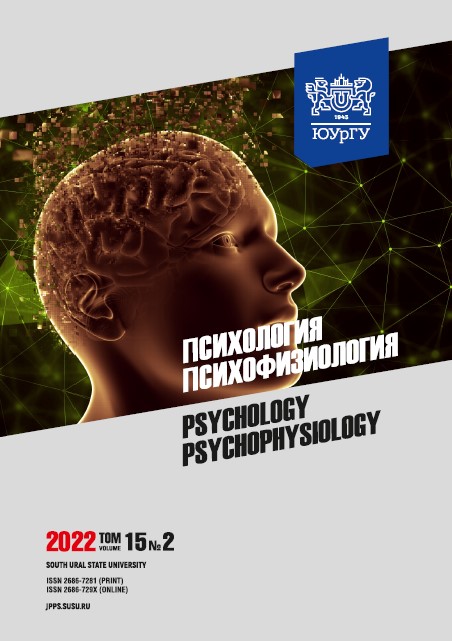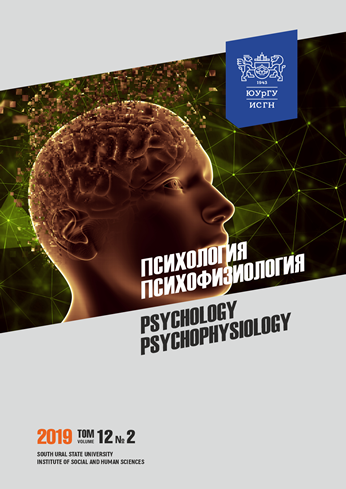Heart rate variability biofeedback training in rehabilitation after coronary artery bypass grafting
Abstract
Introduction. This work is of great relevance because of the importance of early rehabilitation stages in the recovery of patients after cardiac reconstructive surgery. Therefore, there is a need for continuous improvement of rehabilitation programs, including their psychological aspects. Aims. The paper aims to compare heart rate variability measurements before and after heart rate variability biofeedback training in patients after coronary artery bypass grafting. Materials and methods. The study involved 73 patients of the rehabilitation cardiology department (Republican Cardiological Center) who underwent coronary artery bypass grafting, of which 38 were males (51–78 years old), 35 were females (51–78 years old). The mean age of the patients was 64 ± 6.2 years. Biofeedback technologies were used to acquire psychophysiological relaxation skills in the experimental group (37 subjects). Patients were asked to undergo 7–10 cardiac control sessions (depending on the duration of in-hospital stay), 15 minutes for 10–14 days. At the beginning and at the end of rehabilitation, heart rate variability was monitored. Results. The use of heart rate variability biofeedback training at the second stage of rehabilitation resulted in the improvement of heart rate variability in patients after myocardial revascularization compared with the control group. Conclusion. Empirical data confirmed the feasibility of using heart rate variability biofeedback training at the second stage of rehabilitation after coronary artery bypass grafting.
Downloads
References
2. Shabaev I.F. Tarasov R.S., Kozyrin K.A. Hospital results of minimally invasive coronary bypass surgery of the anterior descending artery on a working heart. Kompleksnye problemy serdechno-sosudistykh zabolevanii = Complex problems of cardiovascular diseases. 2019;2(8):58–67. (in Russ).
3. Ardashev V.N., Shchegolkov A.M., Mandrykin Yu.V. Staged rehabilitation of patients after coronary artery bypass surgery. Voenno-meditsinskii zhurnal = Military Medical Journal. 1998;3:41–45. (in Russ).
4. Shakula A.V., Belyakin S.A., Shchegolkov A.M. et al. Medical rehabilitation of patients with coronary heart disease after coronary artery bypass surgery. Vrach = Doctor. 2007;5:1–2. (in Russ).
5. Ivashchenko A.S., Yezhov V.V., Severin N.A., Prokopenko N.A. The effectiveness of medical rehabilitation in ischemic heart disease as part of sanatorium treatment. Evraziiskii kardiologicheskii zhurnal = Eurasian Journal of Cardiology. 2017;2:28–32. (in Russ).
6. Zamotaev Yu.N., Kremnev Yu.A., Podshibyakin S.E. Ocherki meditsinskoi reabilitatsii bolnykh, perenesshikh aortokoronarnoe shuntirovanie [Essays on medical rehabilitation of pa-tients who underwent coronary artery bypass grafting]. Moscow. Agenstvo «Med S.A». 2005:191. (in Russ).
7. Vlasova V.P. Possibilities of BOS technologies in adaptive physical education and rehabili-tation of children with disabilities. Teoriya i praktika fizicheskoi kultury = Theory and practice of physical culture. 2016;8:32–34. (in Russ).
8. Kapilevich L.V., Purushskaya E.V., Krivoshchekov S.G. Physiological foundations of im-proving the accuracy of movements based on stabilographic training with biofeedback. Fiziologi-ya cheloveka = Human Physiology. 2015;4(41):73. (in Russ).
9. Golovanov A.I. Functional biofeedback biofeedback in the rehabilitation of patients with dyscirculatory encephalopathy. Izvestiya Taganrogskogo gosudarstvennogo radiotekhnicheskogo universiteta = News TRTU. 2004;6(41):134–138. (in Russ).
10. Artemyeva E.N. Biological feedback as a method of correction of psychoemotional, behavioral and speech disorders in children of primary school age. Byulleten Severnogo gosudarstvennogo medicinskogo universiteta = Bulletin of the Northern State Medical University. 2016;2(37):8–9. (in Russ).
11. Ivanovskiy Yu.V., Smetankin A.A. Principles of using the biofeedback method in the system of medical rehabilitation // Obshchie voprosy primeneniya metoda BOS [General issues of the application of the method of BFB]. St. Petersburg. CJSC “Biosvyaz” 2008;20–40. (in Russ).
12. Saul J., Bernardi L. Heart rate variability after cardiac transplantation. Heart Rate Variability. Eds. M. Malik, A.J. Camm. N.-Y. Armonk. Futura Publ. Comp., Inc. 1995:479–494.
13. Kuvatov V.A., Mironov V.A., Bavykin M.V., Mironova T.F. Heart rate variability in patients with coronary artery disease with coronary artery bypass grafting. Vestnik Udmurtskogo universiteta = Bulletin of the Udmurt University. 2012;2:68–78. (in Russ).
14. Teplyakov A.T., Lukinov A.V., Levshin A.V. et al. The possibility of noninvasive diagnosis of coronary restenosis in assessing the dynamics of heart rate variability. Klinicheskaya medicina = Clinical medicine. 2010;3:21-26. (in Russ).
15. Heart rate variability: Standards of measurement, physiological interpretation and clinical use. Task Force of the European Society of Cardiology and the North American Society of Pacing and Electrophysiology // Circulation. 1996;93:1043–1065.
16. Kiseleva I.V., Agapov A.A., Akchurin R.S. et al. Heart rate variability before and after coronary bypass surgery in patients with coronary artery disease. Kardiologiya = Cardiology. 2002;7:16–20. (in Russ).
17. Hirsch J.A., Bishop B. Respiratory sinus arrhythmia in humans: how breathing pattern modulated heart rate. American Journal of Physiology. 1981;241(4):620–629.
18. Folkow B., Svanborg A. Physiology of cardiovascular aging. Physiological Reviews. 1993;73(4):725–764.
19. Rogozin A.N. Informativeness of spectral indicators of heart rate variability. Vestnik aritmologii = Bulletin of Arrhythmology. 2001;22:37–40. (in Russ).
20. Demin D.B., Poskotinova L.V. Physiological bases of functional biofeedback methods. Ekologiya cheloveka = Human ecology. 2014;9:48–59. (in Russ).
21. Minko E.A. Evaluation of psychophysiological self-regulation in cardiorehabilitation by heart rate variability indicators. Psihologiya. Psihofiziologiya = Psychology. Psychophysiology. 2021;2(14):123–132. DOI: https://doi.org/10.14529/jpps210212. (in Russ).
22. Poskotinova L.V., Ovsyankina M.A., Krivonogova E.V., Melnikova A.V. Reactivity of vegetative regulation of heart rhythm in the course of biomanagement of heart rate variability parameters in teachers. Sovremennye problemy nauki i obrazovaniya = Modern problems of science and education. 2015;1-1 Available at: http://science-education.ru/ru/article/view?id=19144 (ac-cessed: 03.24.2021). (in Russ).
23. Sergeeva E.G., Ibragimova T.V., Didur M.D. Biofeedback and correction of heart rate variability in athletes training for endurance. Interaktivnaya nauka = Interactive science. 2018;4(26):32–36. (in Russ).
24. Sheikhzade Yu.R., Skibitsky V.V., Katkhanov A.M. et al. Alternative approach to the assessment of heart rate variability. Vestnik aritmologii = Bulletin of Arrhythmology. 2001;22:49–55. (in Russ).
25. Bayevsky P.M. Analysis of heart rate variability: history and philosophy, theory and practice. Klinicheskaya informatika i telemedicinа = Clinical informatics and telemedicine. 2004;1:54–64. (in Russ).
26. Akselrod S., Gordon D., Madwed J.B. et al. Hemodynamic regulation: investigation by spectral analysis. American Journal of Physiology. 1985;249:67–75.
27. Lucini D., Norbiato G., Clerici M. et al. Hemodynamic and autonomic adjustments to real life stress conditions in humans. Hypertension. 2002;39(1):184–188.
28. Boitsov S.A. Agerelated features of changes in heart rate variability in practically healthy individuals. Vestnik aritmologii = Bulletin of Arrhythmology. 2002;26:57–60. (in Russ).
29. Makarov L.M. Features of the variability of the circadian rhythm of the heart in conditions of free activity. Fiziologiya cheloveka = Human physiology. 1998;2(24):56–62. (in Russ).
30. Schwartz P., Ferrari G. Interventions Changing Heart Rate Variability after Acute Myocardial Infarction. Heart Rate Variability. Eds. Malik M., Camm A.J. New York. Futura Publ. Comp., Inc. 1995. P. 407–420.
31. Minakov E.V., Dubachev A.A., Minakova N.E. Characteristics of the dynamics of the adaptation process in patients undergoing coronary artery bypass grafting (based on the assessment of heart rate variability). Vestnik novykh meditsinskikh tekhnologii = Bulletin of new medical technologies. 2010;2(XVII):127–131. (in Russ).
32. Pomeranz, M., Macauly R.J.B., Caudill M.A. Assessment of autonomic function in humans by heartratespectral analysis. American Journal of Physiology. 1985;246:151–153.
33. DiFrancesco D., Tromba C. Muscarinic control of the hyperpolarizing g-activated current if in rabbit sinoatrial node myocytes // American Journal of Physiology. 1988;405:493–510.
References on translit
-Copyright (c) 2022 Psychology. Psychophysiology

This work is licensed under a Creative Commons Attribution-NonCommercial-NoDerivatives 4.0 International License.



